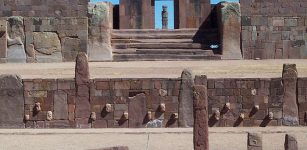Cruithne: Legendary King, His Seven Sons And The First Celtic Tribe That Inhabited British Isles
A. Sutherland - AncientPages.com - An ancient myth says that at the beginning of time, there was a legendary king of the Picts, Cruithne (from the Gaelic word: 'An Cruithain' (Pict) - naturally, 'painted people,' was a son of Cing (in Gaelic: 'strong or brave').
Reconstructed crannog on Loch Tay. Image credit: Dave Morris - CC BY 2.0
Considered to be the father of the Picts, Cruithne, the first king of the Picts, reigned for a hundred years. He had seven sons, and their names were: Fib, Fidach, Foclaid (or Fotla), Fortrenn, Caitt (or Cat), Ce, and Circenn.
If Cruithne really existed, he would have lived about 442 or 476 BC. Historically speaking, the myth seems accurate. These seven provinces did exist within Pictish territories.
In his book, 'The Problem Of The Picts' F.T. Wainwright mentions an ancient account of Scotland called 'De Situ Albanie,' the first of seven Scottish documents ('Pictish Chronicles ') recorded in the so-called 'Poppleton Manuscript,' probably written between 1202 and 1214, in the reign of the William the Lion, by a French-speaking resident of Scotland (north of the Forth).
'Cruithne' also refers to the whole tribe of people – one of the earliest Celtic tribes known to have inhabited Ireland and Britain, who appeared in the British Isles between approximately 800 and 500 BC.
These people (of early medieval Ireland) probably migrated from the mainland; they may have been descendants of prehistoric – native tribes - that inhabited the British Isles since the Stone Age.
Their heartland was in Ulster and included parts of the present-day counties of Antrim, Down, and Londonderry, and they are also said to have lived in parts of Connacht and Leinster. Their name is the Irish equivalent of Priteni, an ancient name for the Celtic Britons, and was sometimes used to refer to the Picts.
However, there is still a debate among scholars as to the relationship of the Cruithne (Cruthin) with the Britons and Picts. Or were they perhaps Partholonians, mythical early invaders of Ireland?
The history of the earliest tribes in the British Isles remains obscure.
The name 'Cruithne' could also be related to the early Irish word 'Cruth,' which means 'shape' or 'design.' Many historians have said that the Picts were the 'painted people,' it has been suggested that they had a habit of tattooing themselves; they may have decorated and tattooed their faces and bodies with dyes.
According to the Collins Encyclopedia of Scotland, "the Picts did not 'arrive' - in a sense they had always been there, for they were the descendants of the first people to inhabit what eventually became Scotland".
The Picts are often described as the descendants of the indigenous Iron Age people of northern Scotland and it is thought that they came originally from Scandinavia as a cohesive group. Since they left no written record of their history, what is known of them comes from later Roman and Scottish writers and from images the Picts themselves carved on stones..."
The Irish called the Picts the 'Cruithne,' and the Romans called them 'Picts,' a general term covering many separate tribes.
"These people had mysterious language and symbols. The Picts’ language is a mystery and the meaning of the symbols stones they left remains an enigma. The language the Picts spoke has been lost, but more than 250 stones with Pictish symbols survived and these can give us a better understanding of the Picts.
Some Pictish stones have written inscriptions. Pictish letters - called 'ogam' - had no curves, so they were well suited for carving on stone..." 1
Written by – A. Sutherland AncientPages.com Staff Writer
Updated on December 11, 2023
Copyright © AncientPages.com All rights reserved. This material may not be published, broadcast, rewritten or redistributed in whole or part without the express written permission of AncientPages.com
Expand for referencesReferences:
Foster, Sally M. Picts, Gaels and Scots
Sir Daniel Wilson, The Archaeology and Prehistoric Annals of Scotland
More From Ancient Pages
-
 Fascinating Discovery – First Female Viking Grave Discovered In Swedish Mountains
Archaeology | Aug 20, 2022
Fascinating Discovery – First Female Viking Grave Discovered In Swedish Mountains
Archaeology | Aug 20, 2022 -
 Ancient Seal Offers First Biblical Evidence Of The Prophet Isaiah?
Archaeology | Feb 27, 2018
Ancient Seal Offers First Biblical Evidence Of The Prophet Isaiah?
Archaeology | Feb 27, 2018 -
 On this day in history: The Battle of the Frigidus – Sep 5, 394 AD
News | Sep 5, 2015
On this day in history: The Battle of the Frigidus – Sep 5, 394 AD
News | Sep 5, 2015 -
 Templo Mayor – Sacred Aztec Complex Dedicated To Gods Tlaloc And Huitzilopochtli Who Were Usually Appeased With Human Sacrifices
Featured Stories | Jan 23, 2018
Templo Mayor – Sacred Aztec Complex Dedicated To Gods Tlaloc And Huitzilopochtli Who Were Usually Appeased With Human Sacrifices
Featured Stories | Jan 23, 2018 -
 Extremely Rare Jurassic Fossils Discovered Near Lake Powell, Utah
Fossils | Oct 16, 2023
Extremely Rare Jurassic Fossils Discovered Near Lake Powell, Utah
Fossils | Oct 16, 2023 -
 900-Year-Old Crypt At Old Dongola: Magical Inscriptions And Mysterious Signs Found
Archaeology | Sep 12, 2015
900-Year-Old Crypt At Old Dongola: Magical Inscriptions And Mysterious Signs Found
Archaeology | Sep 12, 2015 -
 Ancient Mosaic Floor Decorated With Colorful Floral Designs Re-Uncovered After 40 Years
Archaeology | Mar 25, 2023
Ancient Mosaic Floor Decorated With Colorful Floral Designs Re-Uncovered After 40 Years
Archaeology | Mar 25, 2023 -
 Was Alulim, First King Of Sumer And Eridu Biblical Adam?
Featured Stories | Mar 14, 2019
Was Alulim, First King Of Sumer And Eridu Biblical Adam?
Featured Stories | Mar 14, 2019 -
 10 Spooky Ancient Places That Are Home To The Feared Living Dead
Featured Stories | Oct 31, 2020
10 Spooky Ancient Places That Are Home To The Feared Living Dead
Featured Stories | Oct 31, 2020 -
 Superfood Of Ancient Andeans Reconstructed – What Helped To Fuel The Tiwanaku Civilization 2,500 Years?
Archaeology | Nov 30, 2021
Superfood Of Ancient Andeans Reconstructed – What Helped To Fuel The Tiwanaku Civilization 2,500 Years?
Archaeology | Nov 30, 2021 -
 Ancient Maya Nose Ornament Made Of Human Bone Discovered In Palenque
Archaeology | Sep 24, 2023
Ancient Maya Nose Ornament Made Of Human Bone Discovered In Palenque
Archaeology | Sep 24, 2023 -
 Was Tintagel Castle A Fortress Used By Iconic Hero King Arthur?
Featured Stories | Jul 12, 2022
Was Tintagel Castle A Fortress Used By Iconic Hero King Arthur?
Featured Stories | Jul 12, 2022 -
 Excavations At Okazaki Castle Reveal A 400-Year-Old Massive Unbroken Wall
Archaeology | Apr 16, 2016
Excavations At Okazaki Castle Reveal A 400-Year-Old Massive Unbroken Wall
Archaeology | Apr 16, 2016 -
 Puzzling Ancient Artifacts Found In Canadian Mountains Defy Explanation – Scientists Say
Featured Stories | Aug 27, 2024
Puzzling Ancient Artifacts Found In Canadian Mountains Defy Explanation – Scientists Say
Featured Stories | Aug 27, 2024 -
 Why Is Europe Called Europe?
Ancient History Facts | Apr 21, 2016
Why Is Europe Called Europe?
Ancient History Facts | Apr 21, 2016 -
 Brahma: First God In Hindu Trimurti, Creator Of The World And All Creatures
Featured Stories | Apr 17, 2019
Brahma: First God In Hindu Trimurti, Creator Of The World And All Creatures
Featured Stories | Apr 17, 2019 -
 Which Came First: The Reptile Or The Egg?
Evolution | Jun 12, 2023
Which Came First: The Reptile Or The Egg?
Evolution | Jun 12, 2023 -
 Ancient Greek Goddesses Aphrodite And Artemis – Rivalry And Conflict Over Prestige Illustrated In Hippolytus By Euripides
Featured Stories | Jun 13, 2018
Ancient Greek Goddesses Aphrodite And Artemis – Rivalry And Conflict Over Prestige Illustrated In Hippolytus By Euripides
Featured Stories | Jun 13, 2018 -
 Mysterious Maya Snake Kings And Their Powerful Kingdom In The Jungle Reveal More Ancient Secrets
Civilizations | Apr 23, 2018
Mysterious Maya Snake Kings And Their Powerful Kingdom In The Jungle Reveal More Ancient Secrets
Civilizations | Apr 23, 2018 -
 Ancient Napata And Meroe Kingdoms Reveal Secrets Of Queen Tiye And Goddess Maat
Archaeology | Mar 7, 2018
Ancient Napata And Meroe Kingdoms Reveal Secrets Of Queen Tiye And Goddess Maat
Archaeology | Mar 7, 2018



